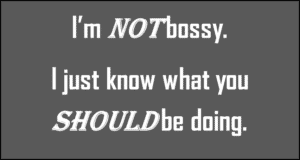
Good leaders tend to be good problem solvers… which is probably why they’re in a leadership role in the first place. Those who are always complaining to their boss about their problems don’t usually climb very high on the ladder of the success.
Great leaders teach others how to solve their own problems. But first we have to learn how to listen.
While raising two beautiful, smart, and successful daughters, I learned (and relearned many times) the hard lesson that sometimes they just wanted me to listen for understanding and not listen to solve.
It’s the same in leadership.
If we haven’t learned how to just listen without trying to solve, we’re robbing our team of opportunities to grow and improve. And we’re certainly not empowering them. In short, we’re hindering their success.

And it’s directly related to increasing empowerment in our future leaders.
Well, you ask, how do we know when they’re struggling with a problem they’re capable of solving themselves? We should know because we’ve been having regular conversations with them, listening for clues they’ve run into a hurdle. Great leaders have enough emotional intelligence to be in tune with their team and can tell when something’s wrong.
If we just can’t discern if they’re looking for a solution after listening for a few minutes, ask them. No, really, ask them if it’s a ‘listen and solve’ or ‘just a listen’. It’s taken me quite a while (decades, if you ask my girls) to intuitively know which it is, but we get better at being able to tell the difference the more we practice listening for understanding.
Then comes the active listen skills, which I’m certain we’ve all mastered:
- Pay attention! Ignore the phone, don’t look at the computer and if we have space, we should get out from behind the desk and sit without a physical barrier between us.
- Show that you’re listening. And I’m talking about non-verbals here, but here’s a warning: non-verbal cues can be easily misunderstood! Case in point: when I’m talking with my wife, I nod when I agree with her; she nods in understanding without regard to whether she agrees. No wonder I’m wrong so often. It’s the same in the office, so we have to be careful about interpreting – and misinterpreting – the nonverbals we’re seeing. Clarify if needed but don’t end the conversation without a clear understanding of the next step(s).
- When the opportunity presents itself, don’t offer a solution! Now’s our chance to ask Do you want my advice? Or how about Do you want me to help you brainstorm a solution? Make it clear we’re not going to do it for them or tell them how to do it, but we will provide the encouragement they need to come up with a solution by themselves.
- Don’t offer the solution Have I mentioned that before? Action-oriented leaders tend to listen until they’ve devised a solution. We grow impatient when the speaker doesn’t get straight to the point, especially when the best solution (ours) is so obvious. The trouble with that is there’s a good chance the problem we just solved in our minds was misdiagnosed to begin with, and we jumped to the wrong conclusion. We wouldn’t know it, of course, because we were only listening to solve.

So next time someone says, “Hey boss, I have a problem,” don’t be in a hurry to tell them how to solve it. We’ve probably seen or heard of it before, and we likely know the fix, but we’re not doing them any favors by cutting the learning opportunity short by listening to solve.
I find I still have to practice just listening. Maybe you do, too.
It’s up to you, leaders.

